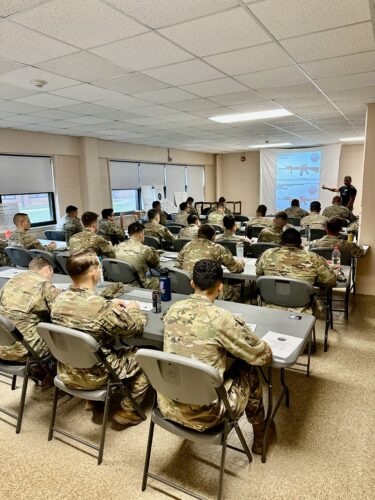
Squad Designated Marksman Course Observations
The following are observations and thoughts gathered from my first time working as an instructor at a US Army Squad Designated Marksman course. Having completed the course myself as a sniper section member in 2017, my career has taken me back to the schoolhouse in this instructor capacity. Shooting and marksmanship are both my passion and my profession, both in the military and outside in the civilian world with my business, Combatant Training Group, LLC. Being able to teach soldiers from across the country more advanced shooting concepts outside of the basic Army marksmanship program is an amazing opportunity. The intent of this piece is to share what I have observed and learned from both the students and other instructors over the span of this most recent class.
Background
The Army’s Squad Designated Marksman course is a 2-week course focused on developing students into shooters who can successfully engage targets in the 300-600 meter “dead-space” between the average infantryman and sniper engagement ranges. During the course, multiple qualifications using the standard M4 must be passed by potential SDMs. These qualifications include a 100-600 yard Known Distance qual using iron sights, 100-600 yard Known Distance using the RCO (ACOG), Unknown Distance qual using iron sights, and Unknown Distance qual using the RCO. Range estimation was a graded event and part of the Unknown Distance qualification.
Before students stepped onto a range or any shots were fired, two days were spent in a classroom covering the topics that must be understood by a shooter looking to reach out to 600 meters. The lessons covered topics such as the principles of shooting, ballistics, the zeroing process, wind and weather effects, shooter/target analysis, range estimation, angled firing, angular units of measure, how to maintain a data-book, and of the utmost importance, just what the job of an SDM entails. So, on that note, just what is a Squad Designated Marksman?
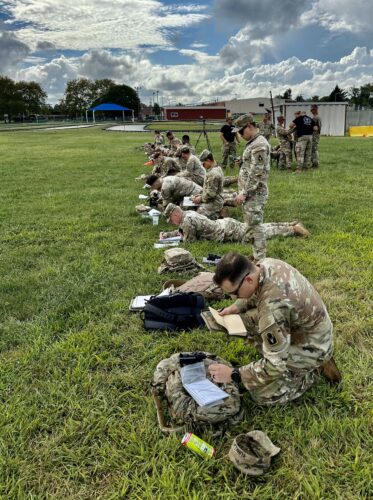
Mission of the Squad Designated Marksman
The primary mission of the SDM is that of a Rifleman within an Infantry squad.
His duties as a Rifleman: to include firing, maneuvering, and providing support for the other members of his squad, take precedence over his duties as a SDM.
The SDM has neither the equipment nor training to operate individually, or in a small team to engage targets at extended ranges with precision fire.
The secondary mission of the SDM is:
Engage key targets from 0 to 600 meters with effective, well-aimed fire using the standard weapon system and standard ammunition.
Since the SDM may not be equipped with an optical sight, he must, therefore, possess a thorough understanding and mastery of the fundamentals of rifle marksmanship.
Supplementary skills: such as a knowledge of ballistics, elevation and windage hold-offs, sight manipulation, and range estimation enhance the SDM’s lethality. His abilities can also be used to help direct the fire of other squad members into enemy positions.
Notice the order of these points. A SDM is NOT a baby-sniper. They are a member of a rifle squad, first and foremost. This is the main reason why the Army’s choice for a SDM rifle is, in this writer’s opinion, the wrong one. The discussion of what type of weapon setup is optimal for a SDM is a very contentious one and will be explored later in this piece. What a SDM really is boils down to the actual skillset of firing a rifle: An SDM is a shooter who can put rounds on a target anywhere from 0-600 meters using anything from an M4 with iron sights to the 7.62x51mm SDMR with a 1-6 LPVO. They are an advanced shooter who can think through individual engagements.
Show Up Prepared
The success of a soldier is very much dependent on the level of competency with a rifle they arrive at the school with. Two weeks is not enough time to take the average soldier and build them into an exceptional marksman from the ground up. A successful aspiring SDM must be dedicated to the craft of shooting. The most successful shooters train outside of the mandatory marksmanship training provided by their unit. Students who arrived already possessing both a solid understanding of and ability to carry out the shot process were the most successful performers. The shooters who possessed these skills were able focus on the new information that was being presented to them in the classroom and were able to process the environment and circumstances for each shot when on the range.
This was in stark contrast to shooters who arrived without an understanding of the fundamentals of shooting. These soldiers struggled with an over-abundance of tasks and data points to remember and process while having to then decide on a wind/elevation hold, all the while thinking about sight picture, breathing, trigger press, etc. These less experienced shooters had to allocate too high a percentage of their processing power to the basic act of firing a rifle. The more advanced shooters were able to focus on the specific environmental factors for each shot and estimating the range to a target, making a wind call, applying a proper hold, and reading the feedback from each shot.
In short, less experienced shooters were focused on firing the rifle properly while more experienced shooters were focused on the environment and potential follow-up shots, for they had the act of firing down to the sub-conscious level.
This was the pre-eminent observation of mine and while it seems obvious, to watch it play out in real time, with real people struggling with ego and emotions was quite an experience. I have been in their shoes. I know what they were dealing with. Observing from the other side while working to make as many soldiers as successful as possible highlighted the deficiencies of our Army as a whole when it comes to marksmanship. At the beginning of the course, I conducted an informal survey of the shooters, asking questions which I believed might help paint a picture of the average soldier who is coming to an advanced shooting course in the United States Army. The questions and answers are as follows:
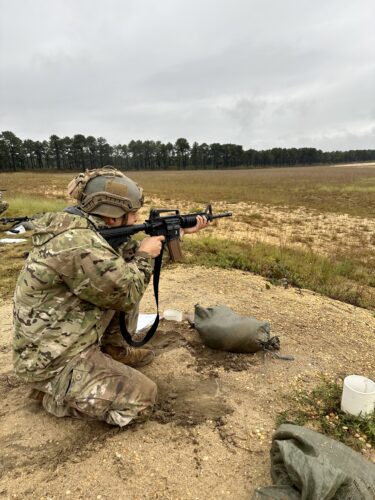
Survey Questions / Answers
MOS (Military Occupational Specialty; their job) Breakdown: 21 Infantrymen, 3 Cav Scouts, 1 Combat Engineer, 1 Medic, 2 Military Police, 1 Blackhawk Mechanic, 1 Truck Driver
Soldiers who have never used an ACOG: 2 of 30
Soldiers who have never shot using iron sights: 5 of 30
Soldiers who have fired a rifle within the past month that was not the standard Army qualification: 11 of 30
Soldiers who have NOT fired a rifle within the past 6 months: 8 of 30
Soldiers who HAD heard of the “Shot Process” (the foundation of the Army’s marksmanship program since 2016): 6 of 30
Soldiers who had never heard of or lack confidence in explaining Minutes of Angle: 13 of 30
Students who know of Garandthumb: 22 of 30
The Rifle of a SDM
As mentioned above, the Army has somewhat recently acquired a rifle that is specifically meant to serve as the SDM rifle. This weapon is known as the Squad Designated Marksman Rifle (SDMR) and it starts its life as a Heckler & Kock MR762A1, chambered in 7.62x51mm. The Army has their specific variant of this platform, known as the M110A1 SDMR.
As issued to the soldier, who, more likely than not, is NOT actually SDM qualified, this FDE colored rifle comes with a suppressor, bipod, Sig Sauer 1-6 Low Powered Variable Optic (LPVO), and offset backup iron sights. Also included are multiple magazines of both 20 round and 10 round variants, cleaning kit, tool kit, manual, and HSGI Taco magazine pouches for the magazines. Point of note here, the magazines this rifle uses are terrible… not so much in function as size profile, for they barely fit in the issued mag pouches and finding pouches that are able to fit them is difficult. I have had the greatest success with the Spiritus Systems Spud pouch.
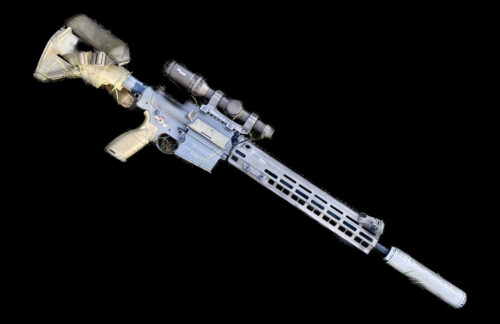
So, what the Army has invested in for a SDM platform is a rifle that does not share the same cartridge of every other member of the squad that the SDM is a part of. This is a major issue. They have instead opted for the classic “battle rifle” cartridge of 7.62x51mm. The supposed reasoning behind this would be that it allows for a less skilled shooter to have more successful hits on target due to the bullets ability to counter wind and reach out farther into that 300-600 meter range where the SDM is supposed to reign supreme in. The general consensus of most is that the 5.56 cartridge is an underperformer past 300 meters. In the experience of people who actually take these guns past 300, this is completely incorrect. I personally have taken a 16” AR in 556 out to 1200 meters with hits on a standard IPSC-sized steel target. Does the 556 require more skill of the shooter in getting out to these ranges due to wind? Yes, it does. However, this is the point of the SDM, to have a more competent shooter.
Having multiple calibers within a rifle squad is a serious logistical issue. Now, leadership will have to decide if, upon the SDM running out of ammunition, they should take 762 rounds from the machine guns in order to keep the SDMR up and running. This is a very likely scenario for the SDM will be carrying less ammunition due to the weight and size profiles of the 7.62x51mm cartridge. Also, we must not forget the FIRST point of the SDM’s mission: The primary mission of the SDM is that of a Rifleman within an Infantry squad. How is this infantryman supposed to provide fire and maneuver capabilities during battle drills with limited ammunition in a heavier battle rifle platform? As discussed above, he will be carrying less ammunition.
The Army has been down this road many times before, and in nearly all circumstances, the 5.56x45mm cartridge was the end result. Of the 30 soldiers that started the course, 28 graduated. That means 28 soldiers, with wide and varying degrees of competence with a rifle beforehand, were able to engage targets effectively out to 600 meters with an M4 and iron sights. So, why would the Army decide to further complicate the logistical situation with a bigger, heavier rifle in a bigger, heavier caliber that looks vastly different than the standard M4, making the bearer of the SDMR one of the first targets of a competent enemy force. Many more reasons abound as to why the chosen caliber is the incorrect one. Personally, it is this writer’s opinion that the 762 H&K rifle is the absolute wrong choice for a SDM rifle. However, the decision has been made and the force is well down the road of fielding and employing these weapons.
A proposed hypothetical alternative to the SDMR would be a rifle chambered in 556 with a 16-20” barrel, suppressor, Geissele SSA trigger, and take the same Sig 1-6 LPVO and mount that on this hypothetical rifle. With this setup, the SDM would have a lightweight rifle that can cross-load ammunition with other squad members and serve far more effectively in carrying out the primary mission of the SDM. The military had quite a few rifles that were very similar to the concept outlined above developed throughout the Global War on Terror. They were known as Special Purpose Receivers/Rifles (SPRs) and were very much lauded for the capabilities added to the unit.
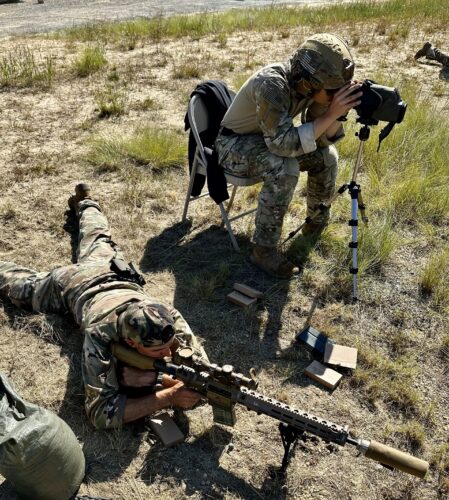
Moving Forward
Alas, the choice had been made years ago by officers who think they know better than the actual end users. And this is why the pre-eminent characteristic of a SDM is not the weapon they are carrying, but the skills of the shooter who carries it. Whether it be M4 with iron sights or a battle rifle with LPVO, a competent SDM will be able to analyze the engagement criteria for each shot, making an informed decision while producing a firing solution. The SDM will serve as a shooter and teacher, taking their skills and bringing them back to their team and squad, hopefully increasing the lethality of the unit as a whole.
Personally, I am very much looking forward to the next SDM course my unit will be hosting. Being able to teach and work with soldiers in the art of shooting is truly one of my favorite ways to spend my time. With this course having wrapped up, the lessons and observations made will be employed during the next course with the intent of creating an even better product for the soldiers who gave up their personal time and put their trust in the schoolhouse to train them on the finer points of marksmanship. And so it continues.

